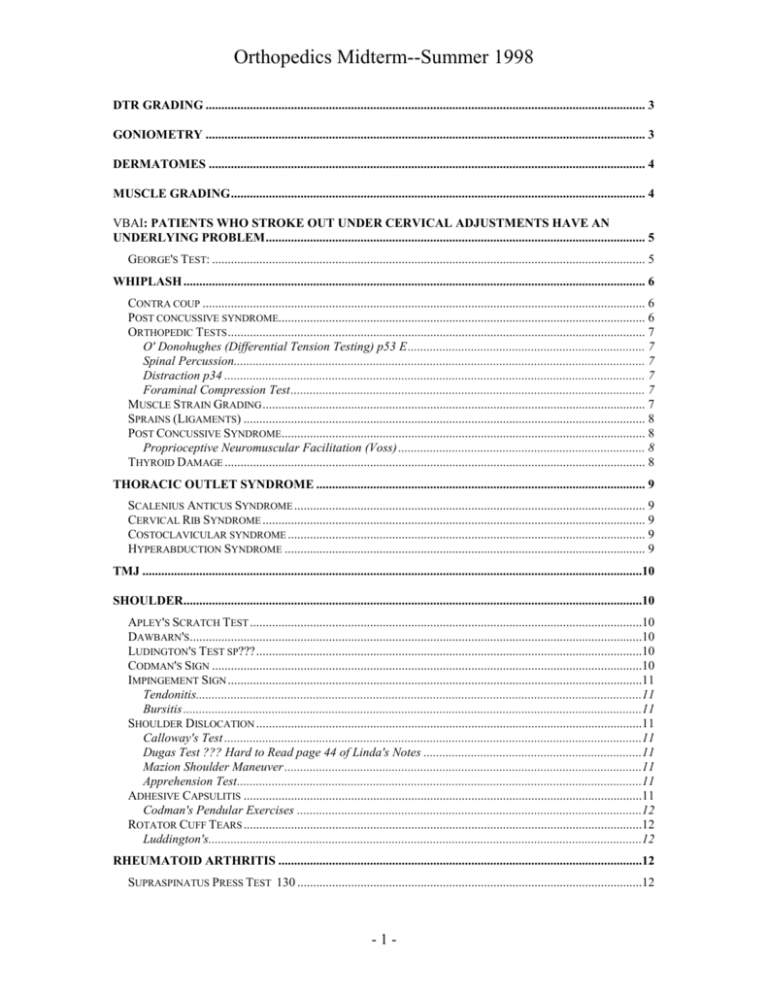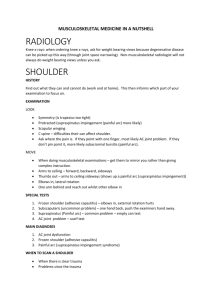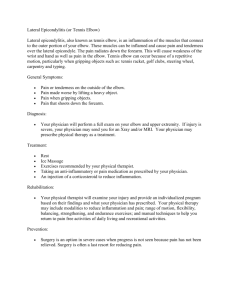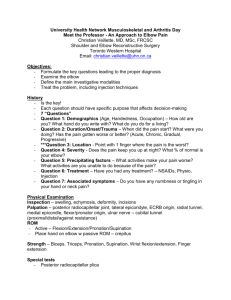Ortho II Notes Part 1
advertisement

Orthopedics Midterm--Summer 1998
DTR GRADING ........................................................................................................................................... 3
GONIOMETRY ........................................................................................................................................... 3
DERMATOMES .......................................................................................................................................... 4
MUSCLE GRADING ................................................................................................................................... 4
VBAI: PATIENTS WHO STROKE OUT UNDER CERVICAL ADJUSTMENTS HAVE AN
UNDERLYING PROBLEM ........................................................................................................................ 5
GEORGE'S TEST: ......................................................................................................................................... 5
WHIPLASH .................................................................................................................................................. 6
CONTRA COUP ............................................................................................................................................ 6
POST CONCUSSIVE SYNDROME.................................................................................................................... 6
ORTHOPEDIC TESTS .................................................................................................................................... 7
O' Donohughes (Differential Tension Testing) p53 E ........................................................................... 7
Spinal Percussion.................................................................................................................................. 7
Distraction p34 ..................................................................................................................................... 7
Foraminal Compression Test ................................................................................................................ 7
MUSCLE STRAIN GRADING ......................................................................................................................... 7
SPRAINS (LIGAMENTS) ............................................................................................................................... 8
POST CONCUSSIVE SYNDROME................................................................................................................... 8
Proprioceptive Neuromuscular Facilitation (Voss) .............................................................................. 8
THYROID DAMAGE ..................................................................................................................................... 8
THORACIC OUTLET SYNDROME ........................................................................................................ 9
SCALENIUS ANTICUS SYNDROME ............................................................................................................... 9
CERVICAL RIB SYNDROME ......................................................................................................................... 9
COSTOCLAVICULAR SYNDROME ................................................................................................................. 9
HYPERABDUCTION SYNDROME .................................................................................................................. 9
TMJ ..............................................................................................................................................................10
SHOULDER.................................................................................................................................................10
APLEY'S SCRATCH TEST ............................................................................................................................10
DAWBARN'S...............................................................................................................................................10
LUDINGTON'S TEST SP??? ..........................................................................................................................10
CODMAN'S SIGN ........................................................................................................................................10
IMPINGEMENT SIGN ...................................................................................................................................11
Tendonitis.............................................................................................................................................11
Bursitis .................................................................................................................................................11
SHOULDER DISLOCATION ..........................................................................................................................11
Calloway's Test ....................................................................................................................................11
Dugas Test ??? Hard to Read page 44 of Linda's Notes .....................................................................11
Mazion Shoulder Maneuver .................................................................................................................11
Apprehension Test ................................................................................................................................11
ADHESIVE CAPSULITIS ..............................................................................................................................11
Codman's Pendular Exercises .............................................................................................................12
ROTATOR CUFF TEARS ..............................................................................................................................12
Luddington's.........................................................................................................................................12
RHEUMATOID ARTHRITIS ...................................................................................................................12
SUPRASPINATUS PRESS TEST 130 .............................................................................................................12
-1-
Orthopedics Midterm--Summer 1998
ABBOT-SAUNDERS ....................................................................................................................................13
ELBOW ........................................................................................................................................................13
VARUS .......................................................................................................................................................13
TINEL SIGN OF ELBOW ...............................................................................................................................14
TENDONITIS OF THE ELBOW ......................................................................................................................14
Common Extensor Tendotinits .............................................................................................................14
Flexor Tendinitis ..................................................................................................................................14
LIGAMENTOUS INSTABILITY TEST 154 ......................................................................................................14
ELBOW FLEX TEST 148 .............................................................................................................................14
COZEN'S TEST *** STANDARD ELBOW TEST *****....................................................................................14
MILL'S *****STANDARD ELBOW TEST ****** ........................................................................................14
GOLFER'S ELBOW TEST .............................................................................................................................15
STENOSING TENOSINIVITIS ................................................................................................................15
DEQUERVAIN'S DISEASE ............................................................................................................................15
Finkelstein's Maneuver ........................................................................................................................15
TRIGGER FINGER .......................................................................................................................................15
GANGLION OF THE WRIST ...................................................................................................................15
DUPUYTREN'S CONTRACTURE ..........................................................................................................15
-2-
Orthopedics Midterm--Summer 1998
5-1-98
The information for the 1st day is the same stuff we are going over in Phys Dx. Such as
Hx and review of systems, VAS,
5-4-98
DTR Grading
+4
+3
+2
+1
0
very brisk; hyperactive; indicative of disease ; associated with clonus
brisker than avg.; could be indicative of a problem
normal
somewhat decreased
no response
Other Scales
+5
sustained clonus (must be stopped by force
+4
transient clonus (stops on own)
Reflexes
Biceps (C5)
Triceps (C6)
Brachioradialis (C7)
Goniometry
Flexion
Use body of C5 as point of intersection (axis)
Place 2 dots on ear
Move base of goniometer to adjust for flexion of thoracics and lumbar
Extension
Have goniometer below the ear but parallel to vertical axis of the ear
Lateral bending
Axis at base of T1
Rotation
Pt. Supine
Axis above odontoid
Follow nose
Standard goniometer procedure
3 measurements in a row
should all be within 5 degrees or 10%
average then round to the nearest 5 degrees
if ROM decreases as you take more measurements, indicates pain syndrome
-3-
Orthopedics Midterm--Summer 1998
if ROM increases as you take more measurements, indicative of soft tissue
injury that doesn't involve splinting of mm.
Passive ROM with overpressure is normal for a healthy joint
If passive ROM = active ROM and overall ROM is reduced ==Ex. Sholder
adhesive casulitis
Normal values are the functional values (minimal value for function
5-5-98
Dermatomes
C5
upper lateral arm
C6
lower lateral arm and thumb
C7
middle finger
C8
little finger and lower medial arm
T1
upper medial arm
T2
axilla
Run 6-8 " at a time
5-6-98
Muscle Grading
+5
+4
+3
+2
+1
0
Normal
Good
Fair
Poor
Trace
none
complete ROM against gravity with full resistance
complete ROM against gravity with some resistance
complete ROM against gravity
Complete ROM without gravity
slight contractility but no joint mvmt
no evidence of contractility
Level
C5
Motor
Deltoid
Reflex
Biceps tendon
C6
Wrist extensors
Brachioradialis
C7
Wrist flexors and digit
extensors
Finger flexion; flexor dig.
Superficialis and profundus
Adduction of digits
Tricep tendon
Sensory
Upper lateral arm
and axillary nerve
(over insertion of
deltoid {epaulette} )
Lateral forearm and
thumb
Middle finger
No reflex
Medial forearm
No reflex
Medial arm
C8
T1
Review
Illiopsoas: hip flexion: T12-L3
-4-
Orthopedics Midterm--Summer 1998
Quads: L2-4 femoral n
Hip adductors: L2-4 obturator n.
L5 extensor digitorum longus and extensor hallucis longus
Hip abduction g. medius L5
** separate L4 and L5 dermatome with the tibial crest
S1 peroneus longus and brevis; gastroc. And soleus; g. max; acchiles reflex; lat foot
dermatome
5-8-98 Today's info comes directly from Terrett
VBAI: patients who stroke out under cervical adjustments have
an underlying problem
George's Test:
not specific i.e a (+) George's does not always indicate an at risk patient
(what they need is an adjustment)
not sensitive : doesn't catch all VBAI's
VBAI signs and symptoms
dizziness, vertigo, light headedness (most common symptom = dizziness)
drop attacks loss of consciousness
diplopia
dysarthria
dysphagia
ataxia
nausea
numbness
nystagmus
TIA's up to 12 - 24 hours return to normal function after the attack
In george's test, you are testing the ipsilateral artery, because it is normal for the
contralateral artery's blood supply to diminish during rotation of the head
Proposed mechanisms
1.
narrowing of the artery as a result of trauma with a hematoma developing ; bruit
sometimes produced
2.
thrombus embolus
3.
dissecting aneurysm
5-11-98
George's Test
-5-
Orthopedics Midterm--Summer 1998
1.
History
Arteriosclerosis
Hypertension
May appear normal but may be taking meds to decrease it
C-spine spondylosis
Hx of neck sprain injury
Want to make sure vertebral artery not injured before adjusting
Former TIA's
CV disease
Diabetes
Family HX of stroke
Stroke
Medications
Oral contraceptives
Aspirin ( if taking a lot in a short period) is an anticoagulant and can
cause GI bleeds (I thought aspirin was a safe drug????)
Coumarin or heparin (derivatives of the main ingredient in rat poison)
That's nice
Strong anticoagulant given in heart valve replacement or deep
vein thrombosis
5-13-98
Terrett p 42 and 19
Whiplash
Rear end collision usually
Acceleration/deceleration
Hyperextension yields a reflex muscular contraction which throws head into
hyperflexion
Headreast at level of EOP (should be)
Too high ( catapult)]
Too low (fulcrum)
Contra coup
Head comes back suddenly
Brain in fluid
Frontal bones slam into brain
Brain moves back while skull is moving and occiput hits brain
Post concussive syndrome
Loss of consciousness not a prerequisite
5/15/98 Guest Speaker--no testable material
-6-
Orthopedics Midterm--Summer 1998
5/18/98
Orthopedic Tests
O' Donohughes (Differential Tension Testing) p53 E
Compares resisted motion(isometric) with passive motion
If muscle damaged will hurt when doing work
If ligament problem pain should not be significantly different
between passive and resisted ROM
Spinal Percussion
Not a good way to diagnose spinal fracture
Gives information about location of pain
Percuss spinouses and paravertebral mm
Distraction p34
Bimanual contact and lift head
General pain across back of neck indicated ligaments
Localized pain indicates capsular problem
Foraminal Compression Test
Ivf involved
Pt presents with myotomal and or dermatomal involvement
with possible parasthesia
Locate area of c/c
With head in neutral position, press down on top of head and
look for increase in radicular pn
Then laterally bend pt and compress
Then laterally bend and rotate and then compress
If problem in compression, distraction provides relief
5/20/98
Muscle Strain Grading
1.
Mild
May be only microscopic damage or can be macroscopic but
damage is small
May heal completely
2.
Moderate
Capillary damage
Longer to heal
More scar tissue (stiffer ) decr ROM
3.
severe (rupture: tearing of at least part of the tendon)
surgical repair often necessary
-7-
Orthopedics Midterm--Summer 1998
Sprains (Ligaments)
1.
mild
2.
moderate
3.
severe (separation/rupture or avulsion fracture)
see rubor, calor, dolar, tumor in sprain
damage to proprioceptors (can lose functional aspects of ligaments)
usually take longer to heal than muscle
more movement allowed which can lead to secondary injury,
but less pain
poor vascular supply
5/22/98
Post Concussive Syndrome
symptoms
light headedness
vertigo/dizziness
headache
neck pain
photophobia (aversion to light)
phonophobia (aversion to loud sounds)
tinnitus
impaired memory
easily distracted
impaired comprehension
forgetfulness
insomnia
fatigues easily
outbursts of anger
mood swings
depression
loss of sexual drive
intolerance to alcohol
hard to document that the symptoms are from the accident
PET scan of brain (be sure insurance will pay)
Proprioceptive Neuromuscular Facilitation (Voss)
Stroke rehab
Thyroid Damage
Symptoms take a while to develop
-8-
Orthopedics Midterm--Summer 1998
Fatigue
Decr labido
Weight gain
Forgetfulness
Often attributed to malingering
5/27/98 Video on whiplash
Thoracic Outlet Syndrome
Scalenius Anticus Syndrome
Compression of the neurovascular bundle as it exits between anterior
and middle scalenes
Usually secondary to cervical injury
Hypertonic scalenes
Post stenotic dilitation of the subclavian artery
May hear bruit
Neurologic and vascular symptoms
Main test: Adson's
Cervical Rib Syndrome
May be bone or cartilage
Forms a ridge that takes up space in scalene triangle
Costoclavicular syndrome
Carrying backpack, suitcase, etc.
Shoulder injuries
Clavicular and 1st rib fixations
Eden's test
Hyperabduction Syndrome
Abduction of the arm increases
Hypertonicity of the pec minor
Rib fixation
Shoulder injuries
Can compress axial artery and brachial plexus
People who work overhead a lot can develop this
Aka Pec Minor coracoid syndrome or P. minor compression syndrome
5/29/98
-9-
Orthopedics Midterm--Summer 1998
TMJ
Hinge jt with anterior translation
When opening jaw, rotation 1st then anterior translation
Often injured in whiplash
Review anatomy
When palpation check for differences in timing and degree of opening
Check whether teeth fit together well
6/1/98
Shoulder
Apley's Scratch Test
Have pt reach above their shoulder with one hand and touch shoulder
blade and other hand under shoulder and try to approximate the hands
Look for lack of pain ???
Look for assymmetry
If you see a problem it is probably rotator cuff mm
Same as deep knee bend (lower ext)
Dawbarn's
P104
Subacromial bursa involved
Bring arm into extension and palpate the bursa
Pt presents with history of shoulder pain
Abduction of the arm relieves the pain
Ludington's Test sp???
Pts hands behind head
Palpate biceps mm for symmetry
If long head of biceps tendon ruptures, initially looks bigger then
atrophies
Codman's Sign
Passive abduction of pt shoulder
Dr drops arm and pt tries to stop
Dr feels for contraction of the delts
Pain with rupture of the supraspinatus or joint capsule
Modified codman's: abduction against resistance
- 10 -
Orthopedics Midterm--Summer 1998
Impingement Sign
Supraspinatus tendinitis
Supraspinatus or biceps tendon
Palpate at site of supraspinatus insertion
Tendonitis
Can get calcium deposits
Body stablilizing area
Bursitis
Usually secondary to something else (tendonitis)
With acute tendonitis and bursitis, area get real red
Shoulder Dislocation
Usually anterior and inferior
Calloway's Test
Measure from axilla to acromion process
The larger side is the dislocated side due to neck of humerus
dropping down
Dugas Test ??? Hard to Read page 44 of Linda's Notes
With affected side, have pt grab other shoulder then push
elbow into chest
Pt will deck you if shoulder dislocated
Mazion Shoulder Maneuver
Same as Dugas but try to raise elbow up
If dislocated pain in front of acromion
Apprehension Test
Abduct shoulder to 90 deg. And flex elbow
Look for apprehension on pt face
6/3/98
Adhesive Capsulitis
Frozen shoulder - aka
Usually secondary to tendonitis or bursitis
Pt uses less which allows for adhesions to form
- 11 -
Orthopedics Midterm--Summer 1998
Codman's Pendular Exercises
Use pendular motion and go into painful ROM and to often
each day
6/5/98
Rotator Cuff Tears
Luddington's
Check for symmetry of the biceps (rupture of tendons)
Rheumatoid Arthritis
Inflammatory condition
Hot swollen painful red joints
Synovial hypertrophy
Pannus formation
Erosion of menisci
Instability
Later on get complete loss of joint function due to ankylosis
Stages
1.
acute
2.
proliferation of pannus
3.
fibrotic ankylosis
4.
bony ankylosis
2-3 X more common in females
*** symmetrical in presentation ****
check for stability especially in C1/C2 area
if too much space between ant. Arch of the atlas and dens can
get cord compression
autoimmune in nature
ulnar deviation of fingers
carpal bones become hard to identify
flexion deformity of thumb (boutonniere)
swan neck deformity of fingers
rheumatoid nodules appear in connective tissue near jt.
Baker's cysts: synovial outcroppings popliteal region
Supraspinatus Press Test 130
Abduct shoulder to 90 degrees and resist abduction
- 12 -
Orthopedics Midterm--Summer 1998
Abbot-Saunders
Abduct and extern rotate
Bring arm down
Listen for click or pop of bicipital tendon
Instability of transverse humeral ligament
Elbow
Valgus: lateral deviation
Vlagus stress test : tests medial collateral ligament
distal body part to the joint is in the more lateral position
Varus
Distal part to the joint is in the more medial position
Varus Stress Test is aducting the distal part and testing lateral collateral
- 13 -
Orthopedics Midterm--Summer 1998
Tinel sign of elbow
Huge % of false positives
Tests ulnar and radial nerves
Lateral side of olecranon radial n
Medial side ulnar n
Tendonitis of the Elbow
Common Extensor Tendotinits
Tennis Elbow
Lateral epiconylitis
Pain more commonly in forearm just distal to elbow
Flexor Tendinitis
Golfer's elbow
Medial epicondylitis
Ligamentous Instability Test 154
Elbow slightly flexed to 20 deg
Hand in supination
Stabilize arm
Abduct forearm to test medial collateral (valgus)
Adduct forearm to test lateral collateral (varus)
If grade III sprain expect hypermobility
Elbow Flex Test 148
Maintain forced flexion for > 5 min
Cozen's Test *** standard elbow test *****
Flex elbow
Pronate forearm
Wrist extended
Pt resists wrist flexion from Dr.
Mill's *****standard elbow test ******
Elbow in flexion
.flex wrist, then fingers
bring elbow into extension and pronation with wrist and fingers still flexed
- 14 -
Orthopedics Midterm--Summer 1998
Cabil Test ?????? check spelling
have pt squeeze sphyg bulb
place band around extensors and do again
should be stronger with band if tennis elbow
Golfer's Elbow Test
elbow flexed, supinated forearm and extended wrist
pt. Tries to flex
6/10/1998
Stenosing Tenosinivitis
synovial sleeve inflamed around tendon
Dequervain's disease
affects tendons of
abductor pollicus longus
extensor pollicus brevis
pain in the anatomical snuffbox
Finkelstein's Maneuver
pt makes fist and dr pushes fist into ulnar deviation at the wrist
pos sign is pain at the distal radius or anatomical sn box
don't immobilize; maintain motion
Trigger Finger
affects flexor tendons proximal to the metacarpal-phalangeal ??? jt.
Finger stuck in partial flexion and can't extend completely
Ganglion of the Wrist
Herniation of the joint capsule or synovial sheaths filled with synovial fluid
Benign
If surgically removed, tend to recur
Most common in the hand and wrist
Dupuytren's contracture
Contracture: permanent shortening of muscle or connective tissue
Contracture of palmar aponeurosis
- 15 -
Orthopedics Midterm--Summer 1998
Limited extension ; flexion OK
Ripples on palmar side
4th and 5th digit m/c
hypertrophy of the palmar fascia
A
G
Abbot-Saunders, 13
abductor pollicus longus, 15
Adhesive Capsulitis, 12
anatomical snuffbox, 15
Apley's Scratch Test, 10
Apprehension Test, 11
Ganglion, 16
George's Test:. See VBAI
Golfer's elbow, 14
Golfer's Elbow Test, 15
Goniometry, 3
H
B
Hyperabduction Syndrome, 9
Baker's cysts, 13
Bursitis, 11
I
Impingement Sign, 11
C
Cabil Test ?????? check spelling, 15
Calloway's Test, 11
Cervical Rib Syndrome, 9
Codman's Pendular Exercises, 12
Codman's Sign, 10
Common Extensor Tendotinits, 14
Contra coup, 6
Contracture, 16
Costoclavicular syndrome, 9
Cozen's Test, 15
L
lateral collateral, 13
Lateral epiconylitis, 14
Ligamentous Instability Test 154, 14
Luddington's, 12
Ludington's Test sp???, 10
M
Mazion Shoulder Maneuver, 11
medial collateral ligament, 13
Medial epicondylitis, 14
Mill', 15
Muscle Grading, 4
Muscle Strain Grading, 7
D
Dawbarn's, 10
Dequervain's disease, 15
Dermatomes, 4
Distraction, 7
DTR Grading, 3
Dugas Test ??? Hard to Read page 44 of Linda's
Notes, 11
Dupuytren's contracture, 16
O
O' Donohughes, 7
P
E
palmar aponeurosis, 16
Pannus formation, 12
Post concussive syndrome, 6
Post Concussive Syndrome, 8
Elbow, 13
Elbow Flex Test 148, 15
extensor pollicus brevis, 15
F
R
Finkelstein's Maneuver, 15
flexion deformity of thumb (boutonniere), 12
Flexor Tendinitis, 14
Foraminal Compression Test, 7
Frozen shoulder - aka, 12
radial n, 14
Reflexes, 3
Rheumatoid Arthritis, 12
- 16 -
Orthopedics Midterm--Summer 1998
TMJ, 10
transverse humeral ligament, 13
Trigger Finger, 16
S
Scalenius Anticus Syndrome, 9
Shoulder Dislocation, 11
Spinal Percussion, 7
Sprains (Ligaments), 8
Stenosing Tenosinivitis, 15
Supraspinatus Press Test 130, 13
Supraspinatus tendinitis, 11
swan neck deformity of fingers, 13
U
ulnar deviation of fingers, 12
ulnar n, 14
V
T
Valgus, 13
Varus, 13
VBAI, 5
Tendonitis, 11
Tennis Elbow, 14
Thoracic Outlet Syndrome, 9
Cervical Rib Syndrome, 9
Scalenius Anticus, 9
Tinel sign of elbow, 14
W
Whiplash, 6
- 17 -






